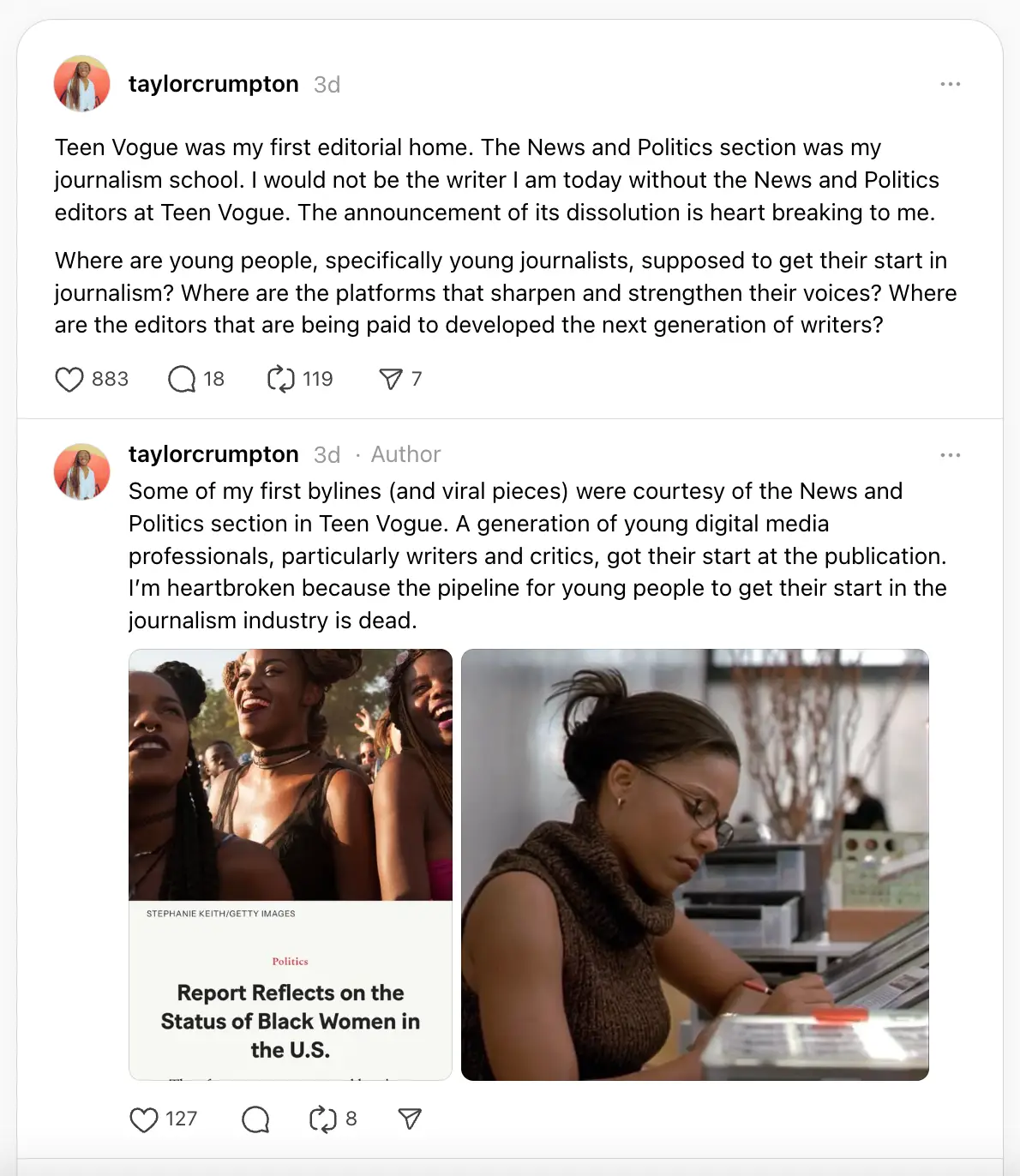Hours before Election Day, where Democrats had their first victory against President Donald Trump, countless journalists mourned the dissolution of Teen Vogue into Vogue, its parent publication. Although Condé Nast promised to keep Teen Vogue’s “unique editorial identity and mission” in a press release, the verbiage around its new mission of “career development” and “cultural leadership” seem to contradict the pledge made by Vogue. The award-winning editorial coverage produced by the youth-centered magazine is the reason why politicians like Mayor-Elect Zohran Mamdani were able to have a historical Election Night. Now, as we enter into next year’s midterm elections, the absence of Teen Vogue’s voice, which brought to light cultural and societal issues that impacted millions of young people in the United States, will be absent from the national discourse about news and politics in our country.
The consolidation of Teen Vogue is not an omen or sign of what’s to come in the media and journalism, but a reminder of the crisis that is already here.
The removal of diverse voices at any time without just cause sets a precedent for the erasure of progressive ways of thought and ideologies that contradict those in power. To siphon off the work of decades-long work of former editorial staff, like Elaine Welteroth, Phillip Picardi, Lindsay Peoples, Versha Sharma, Samhita Mukhopodyay, Dani Kwateng, for fame and recognition, only to cut down the pivotal work of the latest iteration of Teen Vogue staffers, notably Aiyana Ishmael, Kaitlyn McNab, Lex McMenamin, Brittney McNamara, Emily Zirimis, Bea Oyster, and Skyli Alvarez, should be regarded as an attack against the journalism industry. To censure the voices of the next generation of leaders in media, and hinder young people’s access to pivotal work that informs them about legislation that disproportionately has an effect on the ways they live their lives, is a contradiction to the principles of the free press. The health and safety of journalism is directly tied to our First Amendment rights as citizens of this nation.

When Advance Publications, the ownership group behind Condé Nast, owned by the Newhouse family – whose patriarch helped President Trump’s ascension into the White House in 2016 – made the decision to collapse Teen Vogue, it fell in line with the ongoing efforts to remove journalists of color and queer journalists at media organizations, namely CBS News and and NBC News, along with the firing of Karen Attiah from her position as the inaugural global opinion editor from The Washington Post. A healthy media ecosystem welcomes and embraces a variety of opinions and ideas that deviate from norm.
Teen Vogue was reflective of that. The publication regularly published disabled journalists, non-traditional journalists, and gave many writers like myself an opportunity to write on a consistent basis, while in college. For many who got their start at the publication, it was our first editorial home, the first place to legitimize our voices as experts, and the first look at the reality of life as a journalist. The closure of Teen Vogue’s News and Politics vertical is the death of a childhood dream. The last story published by the section was a reported piece on how young people will be affected by SNAP benefits suspension. Even in its final moments, it kept its readers in mind.
The publication was not alone in its efforts to produce thoughtful, insightful news coverage and editorial content. The Flytrap is an intersectional feminist digital media platform, owned and founded by a collective of revered journalists. The platform is raising funds to bring back old web posts from Bitch Media, a pioneering feminist publication known for its pop culture criticism. Worker-owned digital publications – 404 Media, Aftermath, and Defector – have shifted towards an ownership model that is void of corporate interests and political agendas. According to MuckRack’s State of Journalism report, 1 in 3 journalists are independently publishing news, outside of the traditional avenues of media. This figure is based on a survey of 1,515 journalists, most being in the US, and some in the UK, Canada and India.
There is a change taking place within the news and journalism industry within the United States, but I have to ask the following, in the wake of Teen Vogue’s folding:
Where are young people, specifically young journalists, supposed to get their start in journalism? Where are the platforms that will sharpen and strengthen their voices? Where are the funds to pay editors in charge of developing the next generation of young writers?
Young people, specifically young women, are disregarded by those in power. Teen Vogue was a place where they not only felt empowered, but were encouraged to do so. “Female-led publications are incubators for female writers to break into the mainstream. Joan Didion started at Vogue,” writer Eliza Elowen posted on Threads. “Nora Ephron wrote for Esquire. Gloria Steinem founded Ms. Magazine. Jia Tolentino began at The Hairpin.”
The pipeline that once assisted young female writers like me transition into the world of professional writing is dead.
But, there is hope. Hope is the one thing that refuses to die and cannot be killed. In his victory speech, Mamdani said, “Hope is alive”. In Amazing Peace: A Great Christmas Poem, Maya Angelou spoke about the power of hope in great detail:
“Hope is born again in the faces of children
It rides on the shoulders of our aged as they walk into their sunsets.
Hope spreads around the earth. Brightening all things,
Even hate which crouches breeding in dark corridors.”
One should be wary of equating hope with electoral politics, specifically the glorification of one politician as the face of a movement. Yet, one should be hopeful about the ascension of worker-owned, independently-operated media outlets on the rise, whose mere existence is an act of defiance against the forces of censorship that are present in the nation’s media and journalism industry. There is a time to mourn and there is a time to be hopeful. Right now is the time for both.

